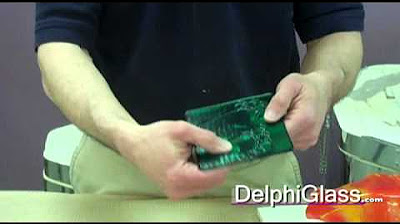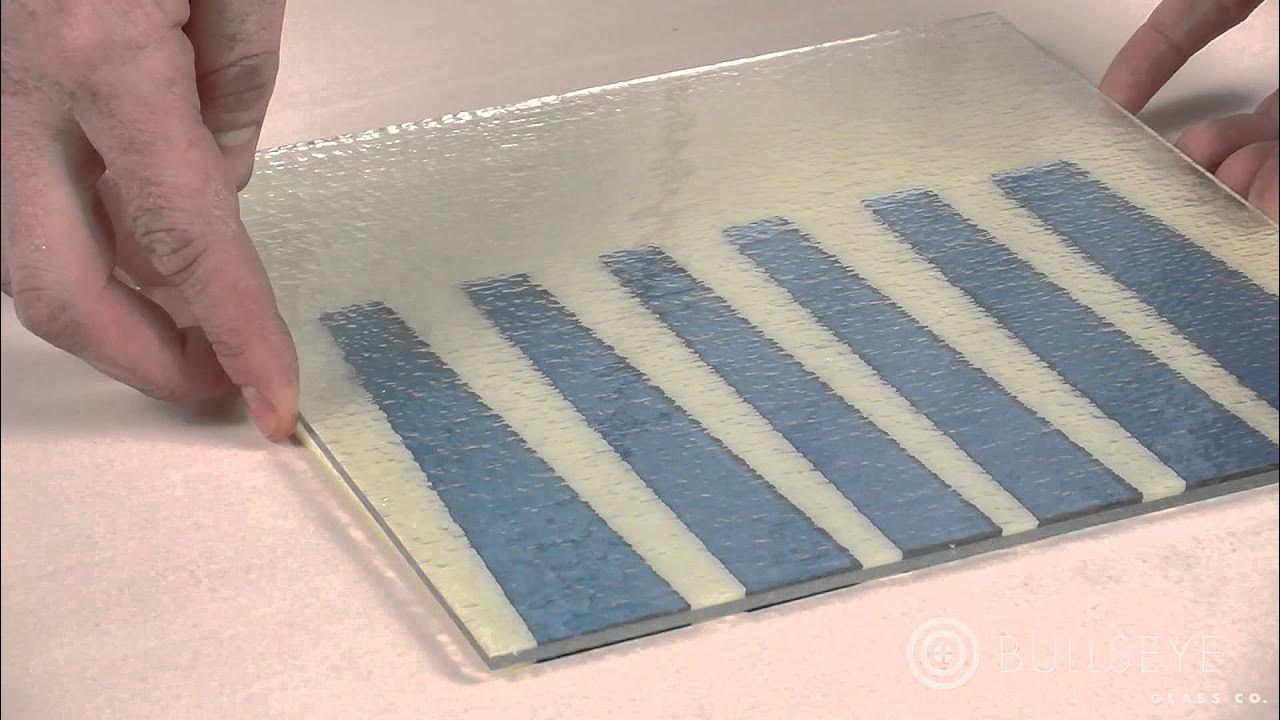Using Fused Glass Jewelry Casting Molds
TLDRIn this video, Jameson shares tips on jewelry making with glass, demonstrating how to repurpose scrap dichroic glass into new pieces. He discusses acquiring affordable materials, cleaning and reusing molds, and applying ZYP Zip to ensure proper adhesion. Jameson experiments with different molds, including those from Creative Paradise, and provides insights on firing schedules for successful glass fusion. The video concludes with the reveal of the finished pieces, showcasing the creative potential of upcycling materials in glass art.
Takeaways
- 🎥 The video is an old one found in the creator's files and is being shared with the audience despite being filmed in hot conditions.
- 🔥 Jameson, the creator, is working in a 104-degree garage workshop and shares some tips on jewelry making with glass despite the heat.
- 💎 Jameson has accumulated a large collection of dichroic glass scraps over three years, emphasizing that it didn't cost a lot to acquire.
- 🛍️ The creator suggests looking for deals on used materials and equipment, like molds, to save money on the potentially expensive hobby of glass fusing.
- 🧼 Jameson demonstrates cleaning old molds with a brush and compressed air, and reapplying ZYP Zip, a release agent, to prepare them for use.
- 📝 The importance of marking molds with the weight and fill weight is highlighted for precision in glass fusing projects.
- 📐 Creative Paradise molds are recommended for their quality and tutorials, and the video shows how to properly fill and use them.
- 🔨 The process of repurposing old jewelry pieces and scraps into new creations is demonstrated, including chopping up and arranging them in molds.
- 🔥 A detailed firing process is discussed, including the importance of a slow bubble squeeze and a long anneal for thick glass pieces.
- 👍 The final results of the firings are shown, with the creator expressing satisfaction despite some pieces being thicker than expected.
- 💬 The video concludes with an invitation for viewers to subscribe, comment, and engage with the community, valuing their input and feedback.
Q & A
What is the main topic of the video?
-The main topic of the video is about repurposing scrap dichroic glass and using molds for jewelry making.
Why did the video creator decide to make a video about their old project?
-The video creator found the old project in their files and decided to share it because they had amassed a collection of dichroic glass and wanted to demonstrate how to use it.
What is the significance of the 'tackle box full of dicro' mentioned in the video?
-The tackle box full of dicro signifies the large amount of dichroic glass scraps the creator has collected over the years, which they have acquired at a low cost.
What is the creator's opinion on the quality of the square pieces of dichroic glass from the clearance sale at Hobby Lobby?
-The creator does not consider the square pieces from the clearance sale to be of the best quality and would not use them for projects with a high cry factor.
How did the creator acquire their molds?
-The creator acquired their molds used, often finding deals online through platforms like Craigslist and Facebook Marketplace, or from people giving up on glass fusing.
What is the purpose of the brush mentioned in the video?
-The brush is used to clean the molds, particularly to remove old spray from the previous owner, in preparation for reapplying the ZIrconium (ZIP) spray.
Why is it important to reapply ZIrconium (ZIP) spray on the molds?
-Reapplying ZIP spray is crucial to ensure that the glass does not stick to the mold and that the posts remain delicate and intact.
What is the significance of writing the weight, fill weight, and total weight on the molds?
-Writing these weights helps the creator to be precise when filling the molds, avoiding the need to constantly check a scale and ensuring consistency in their work.
What is the creator's approach to using the Creative Paradise molds?
-The creator uses the Creative Paradise molds by filling them with frit and capping them with clear glass, following the fill weights provided by Creative Paradise for the best results.
What is the creator's strategy for repurposing the pre-fused dichroic pieces?
-The creator chops up the pre-fused dichroic pieces into different bits and arranges them into molds, then caps them with clear glass and refires them to create new pieces.
What is the creator's advice on firing schedule for the molds filled with glass?
-The creator suggests using a conservative firing schedule, with a high temperature like 1500 degrees, a long bubble squeeze, and a long anneal to ensure the pieces come out well.
What is the creator's experience with the molds after multiple firings?
-The creator has successfully used the same molds multiple times without damaging them, showing that with proper maintenance, they can last a long time.
Outlines
🔥 Summer Jewelry Making with Dicro Scraps
Jameson introduces a video found from last June, where despite the scorching 104°F heat in his garage workshop, he shares tips on jewelry making using a collection of dichroic glass scraps. He emphasizes the affordability of his materials, acquired through clearance sales and online platforms like Craigslist and Facebook Marketplace. Jameson demonstrates cleaning old molds with a stiff brush and compressed air, and reapplying ZYP Zip, a glass adhesive, to ensure the glass pieces don't break off during the fusing process. He also recommends Creative Paradise molds and their tutorials for effective use.
🛠️ Reusing Molds and Dicroic Glass for New Creations
The video continues with Jameson's approach to using old molds and a large collection of dichroic glass scraps for new jewelry pieces. He discusses the idea of repurposing pre-fused pieces from a seller's scrap pile, chopping them up with mosaic nippers, and arranging them into molds to be capped with clear glass and re-fired. Jameson highlights the importance of maintaining the molds with ZYP Zip and being meticulous when loading the kiln to avoid disturbing the Zip and causing the glass to stick. He also mentions his plan for a conservative firing schedule to accommodate the thickness of the pieces.
🔥 Firing Process and Results of Recycled Jewelry
Jameson details the firing process, including a long bubble squeeze at high temperatures, and the subsequent cooling of the kiln. He presents the results of the firing, showing pieces that have varying levels of thickness and some that have picked up Zip on the sides. He notes that some pieces may need to be thinned out with further firings and that the heart-shaped piece and others have come out with interesting dimensions and depth. The video captures the experimental nature of the project and the satisfaction of transforming unwanted pieces into something new and valuable.
🛡️ Cleaning and Repurposing the Fired Pieces
In the final part of the video, Jameson tackles the cleaning process of the fired pieces, addressing issues like Zip residue and the thickness of some items. He considers whether some of the thicker pieces could be used as pendants or magnets and discusses the possibility of further refining the pieces with additional firings. Jameson also reflects on the mold's durability after multiple uses and invites viewers to subscribe and comment, emphasizing the value of community engagement.
Mindmap
Keywords
💡Dichroic Glass
💡Jewelry Making
💡Fusing
💡Molds
💡Zip
💡Creative Paradise
💡Frit
💡Tecta
💡Annealing
💡Kiln
💡Repurposing
Highlights
Jameson shares a previously unposted video from a hot day in June.
Jameson has a large collection of dicroic glass scraps acquired over three years.
Most of the dicroic glass was bought used or found on clearance, saving money.
Jameson demonstrates how to clean and reapply ZYP Zip to mold posts.
Creative Paradise molds were acquired used and cleaned for reuse.
A tutorial from Creative Paradise is recommended for mold filling techniques.
Using a marker to note mold and fill weights on the mold itself for precision.
Jameson discusses the value of reusing and repurposing scrap dicroic glass.
Chopping up pre-fused dicroic pieces to create new jewelry designs.
Using CleanTex to top off jewelry pieces for a clean look with fewer bubbles.
Jameson's kiln firing schedule includes a long bubble squeeze and anneal for thick pieces.
The importance of not disturbing the Zip when loading the kiln.
Overfilling molds to account for glass settling during firing.
Jameson's approach to firing without precise weight measurements for experimentation.
The outcome of the firings, including some pieces with zip residue.
Jameson's satisfaction with the results and the creative possibilities of repurposed glass.
The community aspect of the channel and the importance of viewer comments.
Transcripts
5.0 / 5 (0 votes)
Thanks for rating:





